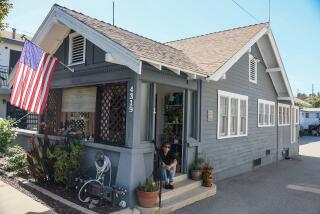Op-Ed: It’s time for L.A. to follow Santa Monica’s lead in regulating tobacco in apartment buildings

Steve Schulman, 56, smokes a cigarette in his hotel room at the Palm Tree Inn in North Hills in November of 2009.
Los Angeles has long been in the forefront of the war on tobacco. Smoking is prohibited in parks, restaurants, restaurant patios, beaches and bars. But unlike in many communities surrounding the city — including Santa Monica, Culver City, Calabasas, Huntington Park, Manhattan Beach, Baldwin Park, Pasadena, South Pasadena, Glendale, El Monte and Compton — tobacco remains unregulated in apartment buildings. In its State of Tobacco Control 2016 report, the American Lung Assn. awarded the City of Los Angeles an F in the smoke-free housing category.
According to the Centers for Disease Control and Prevention, more than 1 in 3 nonsmokers who live in rental housing are exposed to secondhand smoke. About 80 million (1 in 4) Americans live in multi-unit housing and can be exposed to unwanted tobacco smoke in their homes.
A UCLA Center for Health Policy Research study released in April found that policies to prevent smoking are not in place for most market-rate, multi-unit housing complexes in Los Angeles. Nearly 40% of the 1,000 tenants interviewed for the study reported secondhand smoke drifting into their apartments in the last year.
Four out of five tenants, including more than half of those who are smokers, support a smoke-free policy in common areas or individual apartments. Carolina Lopez is one such tenant. Every day, Lopez gasps for clean air as tobacco smoke floats into her Mid-City Los Angeles apartment from her neighbor’s adjacent unit. Unable to convince her landlord to take action, she worries constantly about how toxic secondhand smoke is affecting her health.
Another UCLA study showed that a majority of Los Angeles property owners who do not regulate smoking in their buildings support smoke-free policies in common areas (72% for enclosed, and 54% for outdoor common areas), as well as in all units (55%).
Realizing the dangers of secondhand smoke exposure, the U.S. Department of Housing and Urban Development has proposed mandating that all public housing authorities across the nation ban smoking in order to eliminate tenant exposure to secondhand smoke. If implemented, this decision won’t affect market-rate apartment residents, however, and that amounts to unequal protection.
About 80 million (1 in 4) Americans live in multi-unit housing and can be exposed to unwanted tobacco smoke in their homes.
Libertarians might argue that the government has no business regulating what tenants do in the privacy of their homes and point out that tobacco is perfectly legal for adults.
If smokers were only a danger to themselves, that argument would have some merit. But that’s simply not the case. Secondhand smoke causes lung and other cancers as well as cardiovascular diseases. It is also a significant cause of asthma among children.
The city’s rent-control law could possibly be a barrier to achieving smoke-free apartment housing, since it does not permit a landlord to change conditions of tenancy once a renter has moved into a unit. Indeed, that’s what keeps many landlords from voluntarily imposing or enforcing antismoking policies.
Frequently I hear from distressed apartment residents who have just moved in to what they thought was a smoke-free building. Then it turns out that the tenant next door has lived in the building for many years, and for that reason, cannot be required to stop smoking in or around his unit.
But other California cities with strong tenant protections have found solutions. The City Council of Berkeley, for instance, voted in 2013 in support of a smoke-free housing ordinance, covering all housing of two units or more. Smoking is prohibited inside units as well as on balconies and patios and in common areas. To satisfy Berkeley’s rent-control law, existing apartment residents were asked to voluntarily sign new, nonsmoking lease addenda. (Whether or not they signed, they are expected to comply with the law, but long-standing residents can only be fined, not evicted, for violations.)
Twenty years ago, it may have sounded radical to ban smoking in apartment buildings. At this point, however, it’s the next logical step for Los Angeles — the best way to protect children, seniors and all vulnerable populations in the city from inhaling secondhand smoke against their will in their own homes. Doing nothing would be a missed opportunity with serious public health consequences.
Michael K. Ong is an Associate Professor at the UCLA David Geffen School of Medicine.
Follow the Opinion section on Twitter @latimesopinion and Facebook
More to Read
A cure for the common opinion
Get thought-provoking perspectives with our weekly newsletter.
You may occasionally receive promotional content from the Los Angeles Times.










